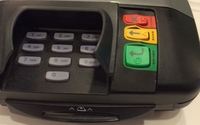Commentary
Mobile Payments vs. the New Chip Credit Cards
- by Chuck Martin , Staff Writer, September 30, 2015
 The deadline for retailers to accept the new credit card types is
tomorrow, which could be a new driver of mobile payments.
The deadline for retailers to accept the new credit card types is
tomorrow, which could be a new driver of mobile payments.
So-called chip & pin cards will be required to be used at all U.S. merchants starting tomorrow. Otherwise, the merchant assumes liability for credit card fraud.
This is all part of the new liability standard also called EMV, which stands for Europay, MasterCard and Visa, the backers of the card and liability transformation.
The reason this can cause a bump in mobile payments is that mobile payments finally may be seen as an easier way to pay.
While a credit card swipe is lightning fast, EMV is not.
The chip card has to be inserted into the checkout terminal and then the consumer waits. And then maybe waits some more.
In the U.S. version of EMV, the customer then will typically have to sign something, either on screen or on a piece of paper that prints. So the U.S. version is more accurately chip and sign.
In other countries, where chip and pin cards have been used for many years, customers enter their card and then a PIN code, everywhere from taxis to convenience stores.
Earlier this week, I bought an iPhone 6S at my local Best Buy, which, like many large retailers, already has EMV terminals installed for checkout. The salesperson who sold me the phone told me to swipe my credit card, which I did. Then another sales associate came over and told us that the card had to be inserted into the slot in the front, which I did.
“Do we have to swipe the card and then insert it?” asked one salesperson to another.
“I don’t think so. I think you can just insert the card,” said the other. “I’m not sure.”
This is an example of part of the short, one-time learning process.
Most notable is that new EMV terminals also typically can accept mobile payments. In the case of my Best Buy purchase, I would have used Apple Pay, except it wasn’t yet set up on my new phone and my iPhone 6 already was deactivated.
But EMV cards may not make mobile payments take off overnight.
Despite this being years in the coming, the majority (56%) of consumer don’t even know what an EMV card is, according to a recent survey of 18,000 U.S. consumers. The study, conducted by Shift Communications for Harbortouch, found that only 22% of consumers currently use EMV cards.
Various other studies also have shown that all merchants are not yet ready to accept chip card payments.
For example, one study out today shows that some categories of retailers are ahead of others.
The study, by the Strawhecker Group, is based on a survey of merchants by category, with a sample of at least 75 retailers in each category.
Since mobile payments are more likely to be usable at the stores that have advanced terminals, here are the store categories where chip cards now can be used, according to the survey:
- 69% -- Shoes
- 59% -- Department stores
- 57% -- Men’s clothing
- 49% -- Miscellaneous apparel
- 47% -- Miscellaneous general merchandise
- 45% -- Furniture
- 44% -- Drapery, upholstery
- 44% -- Jewelry
Store categories with the fewest chip card readers are stationery, book stores, boat dealers and those that that sell children’s and infants’ wear.
Major retailers like Best Buy, Target and Walmart have been ready for EMV for some time, for all the obvious reasons.
It’s somewhat of a different story for smaller retailers. More than a third (37%) of small businesses have no plans to accept EMV cards, according to a recent survey by Cayan. That means mobile payments are not likely to be available there either.
A credit swipe is faster than a mobile payment. However, a mobile payment could be speedier than a chip card transaction.
Starting tomorrow, we’ll start to see which way consumers choose to pay.



